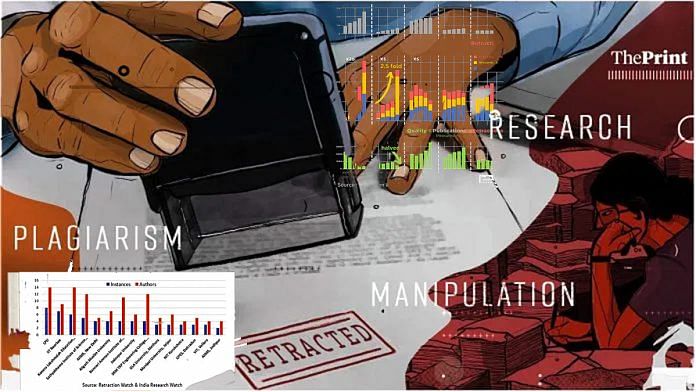New Delhi: Research institutes and universities in India will now be penalised for producing poor-quality research papers.
Professor Anil Sahasrabudhe, chairperson of the executive committee of the National Assessment and Accreditation Council (NAAC), said Friday that the autonomous body responsible for assessing and accrediting higher education institutes in India will now assign negative marks for research papers that are retracted.
“In many institutes, a large number of research papers are getting retracted over a period of two to three years. The credibility of these institutes is an issue. Unless we give negative marks, people will not correct it,” he said, speaking at the two-day Vice-Chancellors’ Conference, organised at Gujarat’s Kevadia.
India is facing a research fraud “crisis”. According to the global research watchdog Retraction Watch, in 2023, India was behind only China and the US with 2,737 retractions. Data shows that retractions from India jumped 2.5 times between 2020 and 2022, compared to 2017 and 2019.
The reasons range from plagiarism to editorial conflicts to involvement in international research papermills. In February this year, an analysis published in the peer-reviewed journal Nature showed that retractions from certain Indian institutes had visibly increased in the last five years.
Speaking to ThePrint after the conference, Sahasrabudhe said the negative marking will be introduced from this year’s National Institutional Ranking Framework (NIRF) as a pilot. “We are working on how to implement this. We need to assess details like from when we should consider the retractions. That is why the rankings are getting a little delayed,” he said.
The NAAC chief also said that this year, the penalty for retractions will be symbolic, but from next year, when the system is more streamlined, the penalties will be more stringent.
“Institutes where retractions are significantly higher will have to face the brunt. We cannot compromise on the quality of research coming from India.”
Also Read: China’s rise in research papers has an unfair ‘home bias’, say US, Japan studies
Indian ‘research crisis’
With rankings like the QS, Times Higher Education and NIRF, not taking retractions into account for scoring, many institutes were climbing the ladder despite alarmingly high retractions from their research wings.
This was also highlighted in a public interest litigation (PIL) filed before the Madras High Court in April, which questioned the transparency of ranking systems like NIRF. The PIL stated that the NIRF rankings were calculated “merely on data provided by the educational institutes on their website, without any verification or auditing”.
The court issued an interim stay on the rankings, which was later lifted after the Centre stepped in, saying a “scientific method” prescribed by an expert body was being followed for publication of the NIRF ranking list.
Academicians have been demanding deterrence for research malpractices.
V. Ramgopal Rao, former director of IIT-Delhi and the current vice-chancellor of the BITS Pilani group of institutes, said that while it is understandable that some retractions stem from genuine and honest mistakes, a large chunk of them are “pure academic malpractices”.
“Ranking framework must incorporate retraction penalties. This was long-overdue. The rankings must adjust their scores to reflect research integrity. They need to assess how much an institute is publishing and how much is being retracted,” Rao said.
Other stakeholders also welcomed NAAC’s decision to penalise institutes for producing poor-quality research.
“We are hoping that the government uses the most exhaustive source for counting retractions, as some paid databases do not index many retractions. The penalties applied also need to be substantial enough to act as a deterrent to those using fraudulent means to publish and get cited,” said Achal Agrawal, founder of the India Research Watch, a non-profit dedicated to calling out academic malpractices.
(Edited by Amrtansh Arora)
Also Read: India’s research crime is getting worse. Scientists are gaming peer review system







Only way to keep a check on research activity is to follow Good Laboratory Practices ie keeping record of entire research work in official record book including material consumed collaborative works undertaken. Regulatory GLP can be used as in principle practice in research institutes to gain credibility. National regulatory bodies can take a call on it.
In experimental sciences, precision scientific instruments are of utmost importance to achieve advancements in cutting edge research. Quantum devices, detectors, nanotech gadgets can bring transformative advancements in research in subatomic domain. Lasers and nonlinear optoelectronics may lead the future research.